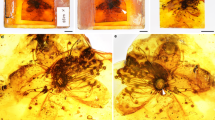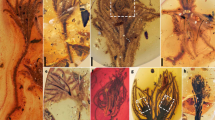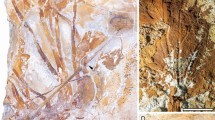Abstract
Flowers are seldom preserved in an identifiable condition. The limited knowledge of floral structure of ancient flowering plants makes comparisons with living plants difficult, as floral structure is the basis for classification of the angiosperms. When found, fossil flowers contribute considerably to our understanding of the evolution of flowering plants1–6. The flowers described here were recovered from Upper Eocene deposits near Anglesea, Australia. They are tetramerous, unisexual, male, with 16 stamens and tricolporate pollen. These flowers, and associated ebenaceous leaves, are the oldest known remains of the Ebenaceae from Australia.
This is a preview of subscription content, access via your institution
Access options
Subscribe to this journal
Receive 51 print issues and online access
$199.00 per year
only $3.90 per issue
Buy this article
- Purchase on Springer Link
- Instant access to full article PDF
Prices may be subject to local taxes which are calculated during checkout
Similar content being viewed by others
References
Friis, E. M. & Skarby, A. Nature 291, 485–486 (1981).
Daghlian, C. P., Crepet, W. L. & Delevoryas, T. Am. J. Bot. 67, 309–320 (1980).
Crepet, W. L. & Dilcher, D. L. Am. J. Bot. 64, 714–725 (1977).
Crepet, W. L. Rev. Palaeobot. Palynol. 25, 241–252 (1978).
Basinger, J. F. Can. J. Bot. 54, 2293–2305 (1976).
Zavada, M. S. & Crepet, W. L. Am. J. Bot. 68, 924–933 (1981).
Hutchinson, J. The Families of Flowering Plants 3rd edn, 1–968 (Oxford University Press, 1973).
Heywood, V. H. Flowering Plants of the World, 1–335 (Mayflower, New York, 1978).
Bullock, A. A. Taxon 8, 154–205 (1959).
Bailey, F. M. The Queensland Flora Part 3, 739–1030 (Diddams, Brisbane, 1900).
Beadle, N. C. W., Evans, O. D. & Carolin, R. C. Flora of the Sydney Region, 1–724 (Reed, Sydney, 1963).
Abele, C. et al. in Geology of Victoria (eds Douglas, J. G. & Ferguson, J. A.) 172–274 (Geological Society of Australia Special Publ. 5, 1976).
Christophel, D. C. in Ecological Biogeography of Australia (ed. Keast, A.) 379–390 (Junk, Netherlands, 1981).
Hill, R. S. Aust. J. Bot. 26, 837–846 (1978).
Hill, R. S. Aust. J. Bot. 28, 105–122 (1980).
Christophel, D. C. Aust. J. Bot. 28, 249–259 (1980).
Cronquist, A. The Evolution and Classification of Flowering Plants, 1–396 (Houghton-Mifflin, Boston, 1968).
Takhtajan, A. L. Bot. Rev. 46, 225–359 (1980).
Lesquereux, L. U.S. geol. Surv. Terr. Rep. 7, 1–366 (1878).
Berry, E. W. U.S. geol. Surv. Prof. Pap. 156, 1–196 (1930).
Hollick, A. U.S. geol. Surv. Prof. Pap. 182, 1–196 (1936).
Chandler, M. E. J. Palaeontgraph. Soc. London 77, 1–52 (1925).
Ettingshausen, C. von Denkschr. K. Akad. Wiss. Wein. 62, 1–56 (1896).
Author information
Authors and Affiliations
Rights and permissions
About this article
Cite this article
Christophel, D., Basinger, J. Earliest floral evidence for the Ebenaceae in Australia. Nature 296, 439–441 (1982). https://doi.org/10.1038/296439a0
Received:
Accepted:
Issue Date:
DOI: https://doi.org/10.1038/296439a0
This article is cited by
-
Fossil Record and Age of the Asteridae
The Botanical Review (2010)
-
Evolution of the Australian flora through the Tertiary
Plant Systematics and Evolution (1989)
Comments
By submitting a comment you agree to abide by our Terms and Community Guidelines. If you find something abusive or that does not comply with our terms or guidelines please flag it as inappropriate.



